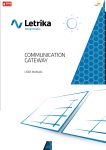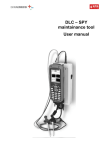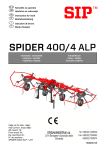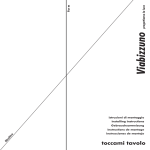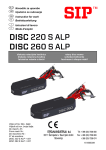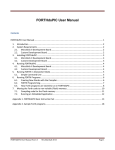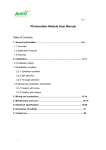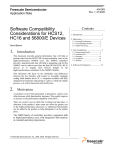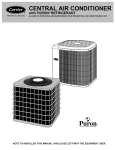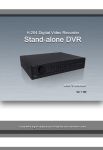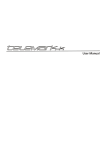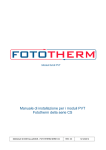Download USER manual MAX 310 v1_1ac_SMS
Transcript
MAX310 BEESMART SoLAR MiCRo iNv RtER 260 USER MANUAL 2 USER MANUAL Copyright All rights with respect to this document, including applications for patent and registration of other industrial property rights, are reserved. Unauthorized use, in particular reproduction or making available to third parties, is prohibited. Disclaimer of liability this manual only describes the product and is not a warranty of performance or characteristic. Contents of the manual has been reviewed against the hardware and software described. Any liability can be accepted for any errors or omissions contained in the information given. the installation, handling and use of Letrika micro inverters are beyond company control. Letrika d.d. does not assume any responsibility for loss, damage, injury or expense resulting from the improper installation, handling, use or maintenance. this user manual only describes the product and is not a warranty of performance or characteristic. We reserve the right to change this document at any time without notice. trademarks Letrika Sol d.o.o. is registered trademarks of the Letrika d.d.. All other brand or product names mentioned in this document may be trademarks or registered trademarks of their respective holders. Who should read this manual this manual is intended to be used during installation, commissioning and maintenance as a reference for installers, system integrators and other qualified personnel with knowledge of local standards and regulations. they should always follow local electrical safety and fire protection guidelines. only technically qualified personnel should install or replace Letrika Micro inverters. USER MANUAL 3 table of contents 1 Introduction 4 1.1 Main features 4 1.1.1 PV Power Plant with Letrika Solar Micro inverters 260 5 1.2 Hardware Structure of Solar Micro Inverter 260 6 2 Safety 8 2.1 Symbols legend used in this manual and/or equipment 8 2.2 Safety and general warnings 8 2.3 General installation safety guidelines 9 3 Installation procedure 10 3.1 Compatible PV modules 10 3.1.1 Landscape versus portrait panels placement 11 3.1.2 Mounting hardware compatibility 12 3.1.2.1 Al profle selection 12 3.1.2.2 3.1.2.3 Inverter fxing screws positions Inverter cooling consideration 12 13 3.2 Connecting cables to micro inverter 14 3.3 Connecting micro inverter system to utility grid 14 3.3.1 Simple single phase connection with I.P.S. device 15 3.3.2 Single phase connection without I.P.S. interface to grid 15 3.3.3 Three phase connection 16 3.3.4 Trunk cable extension and cable end covering 17 4 Commissioning 18 4.1 Preliminary checks 18 4.2 Sequence of operations 18 5 Troubleshooting 19 5.1 List of errors in alarm list 19 6 Storage 22 7 Disposal 22 8 Maintenance 22 9 Registration and warranty 23 10 Appendix 23 10.1 Technical specifcation 23 10.2 Certifcate 24 10.3 Identifcation and oredring code 25 10.4 Dimensions 25 10.5 Compatible dc connector systems 26 10.6 Compatible AC connector system 26 10.6.1 Trunk cable data 26 10.6.2 Accessories 27 10.6.2.1 Waterproof cap 27 10.6.2.2 Cable end cap 28 10.6.2.3 Cable joiner 28 11 Contact 29 4 USER MANUAL iNtRoDUCtioN 1 introduction 1.1 Main features • Nominal Apparent Power 290 vA at power factor f 0,9 • Nominal Real Power 260W • Nominal Reactive Power 260 vAr at 0,95 • Max. Reactive Power 260 vAr • Great efficiency 96,1% • Large voltage and power input range - corresponds to the majority of Pv modules • Reactive power capability – wide range • Dynamic power factor • incorporated relay for safe grid disconnection • Galvanic isolation of DC side from AC side with HF transformer • Low ripple current • 0.0 W standby consumption • WMBUS standard wireless communication • DC circuit is isolated and insulated from ground • Quick installation • Full power at ambient temperature 65°C • Die cast aluminum enclosure with completely potted electronics • iP 67 – dust tight, no ingress of dust; immersion in water up to 1 m for 30 minutes • Foiled capacitor, long life • Design flexibility • Letrika 50 years’ experience in automotive and heavy duty electronics and electro mechanics Protection Function • over and under voltage protection • over and under frequency protection • Anti-island protection • Surge protection device (SPD) integrated • Mains Monitoring Switching Device (MSD) integrated according to vDE 4105 iNtRoDUCtioN USER MANUAL 1.2 Pv Power Plant with Letrika Solar Micro inverters 260 Pv power plant with Letrika Solar Micro inverters 260 consists of several components. Pv module directly convert sunlight into DC electricity, micro inverters change electrical current from DC to AC. Electricity is then transferred via, trunk cables, junction boxes and main distribution switch to the grid . Each Pv module is directly connected to Letrika Solar Micro inverter 260. Pv module and micro inverter is individual power unit operating at maximum available power. the operation of such power unit is independent and does not affect the operation and performance of other power units. Pv modules of different characteristic can be installed in different position and orientation without interfering with each other. the operation of micro inverters can be controlled via Linux based Gateway. Gateway communicates over wireless WMBUS with Letrika Solar micro inverter 260 and over a Wi-Fi or Ethernet with computer, smart phone or tablet. We can monitor and analyze individual micro-inverters or the whole power plant using browser on computer, smart phone or tablet. 5 6 USER MANUAL iNtRoDUCtioN 1.3 Hardware Structure of Solar Micro inverter 260 Solar Micro inverter converts direct current (DC) generated from a single Pv module to alternating current (AC). Each micro inverter use Maximum Power Point tracking (MPPt) to maximize production of single Pv module. Micro inverter has several functional units: Input filter on DC side decouples Pv panel from high frequency transients during DCDC converter switching. DC side power supply of the primary (DCDC) logic is active until minimum panel voltage is reached. Primary DSP controller (16bit , 70MIPS, high performance DSP) calibrates analog system, then starts to sample Pv panel open circuit voltage. After Pv voltage reaches sufficient voltage for reliable start of main flyback power supply, secondary(AC) side logic is turned on. At this point, power supply to both power sections is activated, secondary DSP (32bit,60Mips controller) is started. After successful connection with primary DSP controller, secondary controller will execute auto calibration and after 10 seconds activate WMBUS RF module. this delay is necessary for WMBUS module to stabilize operating parameters and also to avoid unnecessary power oN/oFF cycling in case of low irradiation. WMBUS module converts inverter serial data into 868Mhz data stream according to WMBUS standard. Data from micro inverter can be received by Letrika data gateway or by any device compatible with WMBUS standard. the power DCDC converter is started in constant current mode and high voltage. Energy storage capacitor is charged up to minimum voltage needed for reliable start. voltage level in energy storage capacitor changes with grid voltage, optimizing switching losses on power section. Foiled capacitors are use because they have lower aging compared with electrolytic capacitors. Concurrently DSP2 algorithms are synchronized with grid and operating limits are checked. once DC voltage reaches minimum level, AC inverter power stage is enabled, grid disconnection relay (if present) is turned on and grid current is gradually (according to standards limits) increased. DCDC converter switches to MPPt tracker mode and begins to track Pv panel maximum power point. A high speed iNtRoDUCtioN USER MANUAL Differential mode filters are used for filtering 50 Hz current from inverter carrier frequency,, . Solar Micro inverter is in standby until there is insufficient irradiance and a specific minimum voltage is present in the inverter. the consumption in standby is 0W. the micro inverter starts to fully operate when the sun begins to supply energy and the voltage in Pv module reach 22vdc. Common mode EMC filters are used for EMC interferences filtering. tHD for When the voltage drops below the minimum voltage value (15vdc) feed-in mode ends and the inverter switches off. processor with special algorithm is used to achieve high efficiency and best possible harvest from sun. Surge and Burst protections are used for protecting inverter from lightening phenomena’s and grid over voltages. it is strongly recommended to install external overvoltage protection class ii on AC side, it is also condition for the validity of Limited Warranty. 7 8 USER MANUAL SAFEty 2 Safety 2.1 Symbols legend used in this manual and/or equipment CAUTION Generic danger - important safety information. WARNING Dangerous voltage. All precautions and protections against high voltage electric shock should be taken. Connection to ground protection. Note. Please read paragraph marked with this icon carefully. Hot SURFACE ! Danger of burns, do not touch product. Manual shall be consulted that must be available for future use and not damaged. 2.2 Safety and general warnings WARNING Letrika inverters must be installed only by technically qualifed personal. WARNING All electrical installations must be performed in accordance with local and national electrical standards and codes. CAUtioN in case of fault on Pv installation with Letrika micro inverters, do not attempt disconnect Pv or grid cables from inverters or junction boxes until qualifed personal checks the installation. Hot SURFACE Metal surface of Letrika micro inverters can reach more than 70 degrees in operation. to reduce risk of burns do not touch the inverter while in operation. After switching of micro inverter wait at least 10 minutes before touching it. WARNiNG Do not connect wet connectors. Connectors must be dry before any attempt to connect them. WARNiNG Do not cut, bend or modify original connectors and/or cables supplied with inverters. CAUtioN Lightning protection must be placed on each inverters branch. Avoid wiring loops or rings. Keep cable paths short as possible. if required by local standards, AC wiring must be additionally protected with RCDs and Earth Fault Monitors where required. CAUtioN Before starting inverters for frst time, inspect the wiring, measure isolation resistance between Pv+,Pv- and protective ground. CAUtioN Micro inverters should be mounted on aluminum frame holding the Pv modules. Preferably on upper side to avoid prolonged submersion of inverters into water or snow. Do not left inverters unfxed on the roof. WARNiNG WARNiNG inverter and all metal components must be grounded according to local standards. WARNiNG inverter Pv side is galvanically separated from dangerous voltages; however do not attempt to disconnect PC cables from inverter during operation. WARNiNG Always mount grid disconnection switch between micro inverter installation and grid. WARNiNG there are no user serviceable parts inside Letrika micro inverter. it is strictly forbidden any intervention on micro inverter internal structure. SAFEty USER MANUAL 2.3 General installation safety guidelines the installation must be wired according to local regulations and standards where inverters are mounted. Follow local guidelines for grid monitoring devices and other safety devices to be located between inverters and grid. CAUTION Grounding of all metal parts of the construction is the responsibility of installer. WARNING Micro inverters generates power from more than one source WARNiNG When micro inverter is connected to Pv module and exposed to light, dangerous voltages may appear on output in case of malfunction. WARNiNG WARNiNG inverters with damaged enclosure or wiring must not be repaired and must be returned to producer it is forbidden to connect DC input of micro inverter to the battery or any other DC power supply. Solar micro inverter can be connected only to Pv module. WARNiNG Use only originally supplied cables. Use original end cap from ALtW cable producer to ensure iP67 protection on whole cable trunk. CAUtioN Connect circuit breaker with overcurrent protection according to Pv plant power and local standards. CAUtioN Always fx cables to the frame. Do not allow Pv and grid cables to foat free. CAUtioN if equipment is not used as specifed in this manual and other Letrika documents, protection provided by the equipment may be impaired. 9 10 USER MANUAL iNStALLAtioN PRoCEDURE 3 installation procedure During installation it is a good idea to follow a check list of operations. We will describe general approach that allows installation of the inverters that is easy to manage and maintain. 3.1 Compatible Pv modules Letrika micro inverters are compatible with monocrystalline and polycrystalline panels with 60 and 72 cells per panel. inverter power is not entirely used, efficiency is lower and this affect the production of electricity. thin film panels are normally not suitable because of higher panel dc voltage incompatible with micro inverter input range. However some thin film panels with output voltage of approx. 50v can still be used with Letrika micro inverters. thin film modules have a risk of tCo corrosion. Consult the producer of thin film panels how to ground the positive or negative terminal of the Pv module. Letrika Solar micro inverter 260 allows using the positive or negative grounding. When higher power Pv modules are used, consider that the micro inverter can deliver approx. 300W of AC power for approx. 20 minutes at 30°C. Pv modules from 220Wp up to 310Wp can be connected to the inverter. Using lower power Pv modules, the micro During selection of Pv modules power consider also average and peak operating ambient temperature. From the point of view of micro inverter performances, there is no derating in performances until 65 degrees ambient temperature is reached. open circuit voltages (Uoc) and short circuit currents (isc) of Pv modules shouldn’t exceed the declared values in technical specification. iNStALLAtioN PRoCEDURE 3.1.1 Landscape versus portrait panels placement Portrait or landscape layout could be used when installing more Pv panels. Layout of Pv panels will affect the choice of trunk cable. if the layout is portrait the distance between the connections on trunk cable are every 1,05 m. if the layout is landscape the distance between the AC connections on trunk cable are every 1,70 m or 2,00 m. Landscape panels orientation Portrait panels orientation USER MANUAL 11 12 USER MANUAL iNStALLAtioN PRoCEDURE 3.1.2 Mounting hardware compatibility Letrika Solar micro inverter is designed to be compatible with most standard Al frames. During frame selection few important thing must be observed. 3.1.2.1 Al profle selection Al profile must have a t shaped groove for M8 or M6 nut. M8 screw inserted into t shaped groove. if screw is inserted it is easier to place and fix the micro inverter. Screws must be inserted before the frame is assembled, since they can`t be moved across frame junctions. if M8 or M6 nuts are inserted into profile care should be taken during screw length selection, since long screws can damage the AL profile or they cannot fix micro inverter adequately. Use M8 or M6 screws and nuts. Do not use smaller or larger screws for fixing the micro inverter Al profile width must match micro inverter fixing tab length. there are several possibilities how to mount the inverter on the profile each with advantages and disadvantages. 3.1.2.2 inverter fxing screws positions install the mounting screws (M8 x 16) on the body of the supporting structure at intervals of 130 mm and installation of the casing by tightening the bolts to torque Nm 9. Do not over torque. iNStALLAtioN PRoCEDURE USER MANUAL 3.1.2.3 inverter cooling consideration For proper inverter operation and full performance delivery some mounting guidelines must be observed. Although micro inverter does not need any forced ventilation and is cooled by natural heat exchange with surrounding air, it still need some air around its aluminum enclosure to cool efficiently. We strongly suggest to place micro inverter at least 15mm bellow the panel surface and to leave at least 20mm between inverter and underneath surface to avoid panel heating and micro inverter overheating. Micro inverter can be positioned above or below supporting Al frame, as indicated on drawings bellow. Placing micro inverter on bottom side of Al support, decrease heat transfer from micro inverter to solar panel, increasing efficiency on high ambient temperatures. Recommended mounting for optimal heat dissipation (micro inverter on bottom side of supporting frame) Mount micro inverter in locations, which are out of direct sunlight. We do not recommend mounting micro inverter directly between panel and roof surface since air irculation is not guaranteed. Efficiency of the system will be decreased and the micro inverter and the panel can be overheated if mounted like shown on bellow drawing. if micro inverters are mounted as showed above, warranty period is voided. Forbidden micro inverter mounting Recommended mounting for optimal heat dissipation (micro inverter on top of supporting frame 13 14 USER MANUAL iNStALLAtioN PRoCEDURE it is a good practice to mount inverter in the middle of the panel width, regardless if the panel is placed in portrait or landscape position. Horizontal placement of the inverter 3.2 Connecting cables to micro inverter Connecting cables to micro inverter is simple. Just connect DC cables connectors into matched panel DC connectors coming from panel junction box. Push connectors together until they latch with audible CLiCK. Some DC connectors are marked with + and – engraved on plastic. Polarity is valid for panel side. on micro inverter, we placed two additional colored signs on DC wires. BLUE for DC- and RED for DC+ wire. Please take care about right polarity while connecting inverters. Before connecting the inverter measure voltage polarity on Pv module. insert AC connector from inverter into t junction connector on the cable. Again, push connectors until audible CLiCK is heard and connector is latched. Connecting cables to micro inverter 3.3 Connecting micro inverter system to utility grid Micro inverter must be connected to the utility grid in accordance with local standards and permissions. Letrika Solar micro inverter 260 has built in interface protection system (iPS) according to vDE 4105. All frequency, voltage and anti-islanding protections are embedded inside micro inverter. Also power factor, voltage control functions are built-in. inside micro inverter is a relay with double contacts to physically disconnect micro inverter from the grid. External iPS must be connected between micro inverters and grid if required by local standards and permission. We strongly suggest to mount surge protection devices into roof junction box or better, to use surge protector systems that are mounted in same housing as micro inverter and can be connected to standard ALtW Pt 3 wire system allowing placement of surge protections also in between micro inverters improving surge immunity. Please contact Letrika for details on surge protection devices. iNStALLAtioN PRoCEDURE USER MANUAL 3.3.1 Simple single phase connection with i.P.S. device inverters are simply connected to ALtW Pt-3 trunk cable. See table 1 for maximum allowed number n of micro inverters per trunk. i.P.S. device may vary from country to country, please check with local distributor company. Not used t junctions on trunk cable must be covered with watertight cap. Single phase system with i.P.S 3.3.2 Single phase connection without i.P.S. interface to grid Since Letrika micro inverters have built in i.P.S. according to vDE 4105 standard with incorporated disconnection relay, they can be used, if a local standard permits, Single phase connection without i.P.S inteface without additional i.P.S device interfacing to grid, only grid disconnection switch must be used. 15 16 USER MANUAL iNStALLAtioN PRoCEDURE 3.3.3 three phase connection Micro inverters can be connected also on three phase grid system. Although they can operate even in event of one or two phase failure, it is generally not recommended, and in some countries also forbidden to operate with one or more phases interrupted or in short circuit. it is recommended to use protection against unbalanced load. iNStALLAtioN PRoCEDURE USER MANUAL 3.3.4 trunk cable extension and cable end covering Guidelines for trunk cable extension and cable end covering are showed below. it’s not allowed to extend the trunk cable above maximum number of t junctions specified in table 1. trunk extension is normally necessary when panels and micro inverters are mounted on different places on the roof, making difficult to connect them only by using trunk cable. Always use original cable joiner CX-04BCM32-7002 to ensure trunk cable join point water tightness. Figure 12 trunk cable extension and cable ending insert CAP-WtCASMA2 on exposed cable end since original water tight cap ensure iP67 protection of exposed trunk cable end. if trunk extension is done by using customer supplied cable, please note that the cable must be Uv reinforced cable with cold bending 90 degrees at -40°, 90° maximum temperature. 17 18 USER MANUAL CoMMiSSioNiNG 4 Commissioning Commissioning should be done by technically qualified personal. Connecting cable output AC and DC voltage input cables should be carried out in accordance with the manufacturer's instructions (AMPHENoL). 4.1 Preliminary checks • Check the data on micro inverter and verify compliance of these data with grid data • Check the position of all connection cables and the tightness of all nuts and terminals • Peel the label with Serial number and attach it to the matrix in the same order as they are installed. • Check the micro inverter is firmly mounted • When conducting the checks, ensure that the main AC disconnector switch (downstream from the system) and any other possible isolation switches are switched off position • Ensure that all conductors and protective grounding points are connected 4.2 Sequence of operations • Switch on the main AC disconnector switch (downstream from the system) and any other possible isolation switches • Proceed with configuration of Gateway. Details are described in Gateway User Manual. • Ensure that all electrical safeguards have been correctly installed • Ensure that the complete system has been checked, tested and approved in accordance with the local standards and codes tRoUBLESHootiNG USER MANUAL 5 troubleshooting the operating state of the micro inverters can be monitored on the Gateway LCD. LCD shows the status of the plant on default view. in normal operation the status is »working«, it means that everything is oK. if an internal or external fault occurred, the LCD displays status: »alarm« . Gateway stores errors in alarm list, which can be at any time retrieved from it with web application. the inverter will not feed the grid while the alarm on LCD is present. only technically qualified personal may perform work on electrical installation. Example of Alarm history from web application 5.1 List of errors in alarm list 1 ERR_OVER_ CURRENT_SW over current on AC side is detected by software. Possible cause is short circuit on grid lines or sudden voltage drop on grid lines. Proposed action: • Check connecting lines • Check surge protections on lines • Check external power capacitors banks for power factor corrections • Scan grid voltage for deeps 2 ERR_OVER_ CURRENT_HW over current is detected by hardware. Possible cause is very high short circuit current, very deep voltage transients or high voltage surge spikes. Proposed action: • Check connecting lines • Check surge protections on lines • Check external power capacitors banks for power factor corrections • Scan grid voltage for deeps 3 ERR_OVER_ VOLTAGE this signal is active if DC high voltage too high. Possible cause for DC high voltage to rise above safety limits is very unstable grid with changing shadows on Pv module. Proposed action: High voltage spikes from grid are transferred to DC high voltage capacitors Check grid voltage and transients 19 USER MANUAL 20 tRoUBLESHootiNG 4 ERR_UNDER_ VOLTAGE DC high voltage is too low. During operation on high output power, deep shadowing occurred. it is possible that DC voltage drops too low and it is not possible to push the current into the grid. Proposed action: • Check DC connectors • if under voltage is repeated on same panels, check all connections 5 ERR_ADC internal circuit problem internal circuit calibration failed Proposed action: • Replace inverter 6 ERR_PANEL_ VOLTAGE_LOW Panel voltage is too low to operate. inverter detected too low voltage on Pv panel to ensure correct energy transfer to secondary side. Proposed action: • Wait panel voltage to rise up, if this error insist under heavy sun, then check panel voltage or replace inverter 7 ERR_OVER_ TEMPERATURE_ CONTROLLER DC or AC side power section over temperature. temperature on DC or AC power section reached maximum allowed temperature, approx. 90 degrees centigrade. Proposed action: • check ambient temperature is lower then 65 degrees • check inverter exposure to direct sun light • air is not circulating across inverter enclosure 8 ERR_PARAMETERS_ CORRUPTED internal Country and other parameters corrupted. internal FRAM memory corrupted. Proposed action: • Replace inverter 9 ERR_ADC_OFFSET_ ERROR internal ADC ofset to high. internal analog to digital converter ofset is out of adjustable range. Proposed action: • Replace inverter 10 ERR_INTERPROC_COM CRC error in interprocessor communication. An CRC error occurred between both DSP controllers on inverter. Proposed action: • Error should reset automatically after some time, if not, replace inverter 11 ERR_GRID_VOLTAGE Grid voltage to high or too low. Grid voltage is out of limits, according to country standard. Proposed action: • too much inverters on grid line • installation close to grid low voltage transformer • Grid without power factor correction capability tRoUBLESHootiNG USER MANUAL 12 ERR_GRID_FREQUENCY Grid frequency out of range. Grid frequency is out of range prescribed in standard for given country. Proposed action: • verify grid frequency, if condition insist or this error is noticed on all inverters in installation, • Check for locally installed generators, other solar installations or wind turbines, which can cause frequency slipping • Check for islanding operation of the inverters 13 ERR_SYSTEM_SW Firmware CRC error. inverter frmware auto test detected frmware CRC error in one of DSP controllers. Proposed action: • Replace inverter 14 ERR_COMMUNICATION_ TIMEOUT No communication between DSP processors. Main DSP processor can not see any communication from DCDC DSP controller. Proposed action: • Wait inverter to reset during the night. if condition persist, replace inverter 15 ERR_GRID_DISCONNECTED No grid Grid is disconnected or internal PLL can not catch any valid sinusoidal signal Proposed action: • No grid connected, very distorted grid current, very low grid voltage. 16 ERR_IGRID_DC_COMPONENT DC current injected to grid is too high. internal circuit detected too high DC current injected to grid. if condition is rare, than some transients can cause inverter to trigger this error. Proposed action: • if condition repeats continuously, then check other sources on the grid that might cause DC current in it, restart inverter, or if condition persists, replace inverter. 17 ERR_FAST_LOOP_INT 18 ERR_SLOW_LOOP_INT internal frmware errors, safety shut down. Proposed action: • if problem persist, replace inverter 19 ERR_STATE_MACHINE 21 22 USER MANUAL 6 Storage the equipment must be stored in suitable warehouses. After long period of storage clean accurately micro inverter before installing it. Check the contacts that are not oxidized. 7 Disposal the owner of micro inverter must dispose it in accordance with local directives and regulations. it is forbidden to deposit electrical and electronic equipment as municipal waste. the complete procedure after lifetime should comply with Directive 2012/19/EU of the European Parliament and of the Council of 4 July 2012 on waste electrical and electronic equipment (WEEE). Micro inverter can be send back to manufacturer or provider for disposal. Delivery costs in this case are covered by sender or owner. Component and material identification: • Housing Aluminum • Filler - PU • Gaskets and seals Rubber / tefon / viton • Electrical cables Copper / Rubber • Conduits Polyethylene / Nylon • HF transformer - Fe 8 Maintenance Micro inverter should be inspected and cleaned if necessary at least once a year. it is recommended to regularly check for signs of damage. Regularly check for dust, dirt and moisture. if necessary clean the device. For cleaning use compressed air, a vacuum cleaner or special brushes. Although original cable system used on Letrika micro inverters is state of the art with extra-long live, resistant to water, Uv, temperature, oil and moisture, we suggest to check connections between inverters every year. Special attention should be placed on junction boxes where most of bad connections and problems can occur. USER MANUAL 9 Registration and warranty the standard product warranty for Solar Micro inverter 260 and is 5 years. it is possible to extend the system warranty to 7 years by registering to Letrika Sol at www.letrikasol. sol. By registering also Limited warranty for 25 years becomes valid. All warranty conditions are available on the web side. 10 Appendix 10.1 technical specifcation DC OPERATING PARAMETERS Maximum DC input power 310 Wp Maximum DC input voltage 60 V MPPT voltage range 22-55 V Operating range 15-60 V Start-up DC input voltage 21 V Maximum DC input current 10.5 A Short Circuit DC input current 12 A Panel ripple current 50m A DC connection system Amphenol MC4 AC OPERATING PARAMETERS Nominal apparent power 290 VA Nominal real power 260 W Nominal reactive power 128 VAr at cosϕ=0,9 Grid voltage range 185-270 V 1ph Maximum AC current 1.26 A Nominal frequency 50 Hz 47.5..50.5Hz Peak Power 15 min 290 W Power factor range 0.8-1 limited with ambient temperature • Dynamic with power • Dynamic with voltage-frequency • Fixed between 0.8 to 1 Maximum overcurrent protection 2A Inverters per trunk 20 AC connection system Amphenol LTW SPS 03 connection system UL & VDE approved 23 USER MANUAL 24 APPENDiX AC PROTECTION Anti-Islanding According to local standard Overcurrent 2A PERFORMANCE Peak Efciency 96,1% CEC Efciency 95.5% EURO Efciency 95,3% MPPT tracking Efciency 99.9% Stand-by consumption 0W ENVIRONMENTAL Ambient temperature -40 … +65 °C Relative humidity 0..100% Ingress Protection Rating IP 67 Maximum altitude 2000m Noise 30db(A)@1m Cooling Mounting brackets Natural 209x243x38mm with brackets M8x16, distance 130 mm Weight 2200g Housing Die casted aluminium Dimensions Communication WMBUS Lifetime expectancy 25 years Limited Warranty 25 years VDE 4105 CEI 0-21 EN 62109-1 EN 62109-2 EN 61000-6-3 HF transformer Standards Isolation Level Safety class Overvoltage Category I II (input DC) III (input AC) 10.2 Certifcate Solar Micro inverter 260 was tested in accreditation laboratory according to international standards. Certificate can be downloaded at: www.letrikasol.si no derating EN 13757-1 … 5 reinforced insulation APPENDiX 10.3 identifcation and oredring code ordering code: AEi-1101-S-C70-P260-F50-U230- vDE-ALtW-G Where: AEi 1101 S C70 P260 F50 U230 vDE ALtW G Family name Family member input type – S is for solar photovoltaic DC input Cells on Pv panel output power 260W output frequency 50Hz output voltage 230vac Settings according to standard vDE4105, other CEi for CEi-0-021, G83, CSL type of AC connector for grid connection 10.4 Dimensions USER MANUAL 25 26 USER MANUAL APPENDiX 10.5 Compatible dc connector systems Pv connectors are compatible with MC4 standard connectors. on request, other types of connectors are available. Amphenol LtW H4 connection system 10.6 Compatible AC connector system Amphenol ALtW connection system is composed from one single AC cable from micro inverter and trunk cable where up to 20 inverters can be connected. Both AC cable and the trunk are equipped with locking connectors that can be separated by using special unlock key and they are iP67 rated. Reliability, current capability and lifetime are considerably increased by using direct trunk connector and cable molding technology and by using insulation displacement main cable contacting, without interruption of main cable. two types of cables are available UL and vDE approved, while connectors are always the same. Cables and plastic materials are chosen and tested under most harsh conditions imaginable and they are Uv, salt fog, oil, temperature and bending resistant. Please, do not cut, disassemble or modify connectors and cables. Do not use matching products that are not produced by ALtW since cable performances can be altered and possible dangerous situations may occur. in addition to two basic connectors, some more additional connectors are available for cable ending or joining. 10.6.1 trunk cable data very important is to choose the right trunk cable pitch, depending on panel dimensions and orientation. Consider that also maximum number of micro inverters per trunk change with connectors pitch. See bellow tables and drawings for details. Trunk cable ID: Panels orientation: Max. number of T connectors on trunk : Pt-3-4A-105-00-020-EU Portrait 20 Pt-3-4A-170-00-018-EU Landscape-170 cm panels 18 Pt-3-4A-205-00-017-EU Landscape-205 cm panels 17 Pt-3-4A-105-00-020-UL Portrait 20 table 1 trunk cable types and maximum number of micro inverters per trunk APPENDiX USER MANUAL Figure 13 ALtW trunk cable drawing 10.6.2 Accessories For easier waterproof cable elongation end ending, some additional accessories are available: 10.6.2.1 Waterproof cap Waterproof cap is used as watertight cover on unconnected t junctions on trunk cable. White plastic cap originally attached on t junctions iS Not watertight; it is there only for dust and mechanical protection during transport and installation. in case some t junctions are left unconnected, use this cap to water tight the junction. CAP-WSMMFLA-P1 27 28 USER MANUAL APPENDiX 10.6.2.2 Cable end cap Cable end cap is used for watertight closing of exposed cable end. Simply push the cable into end cap, the wires inside the cable are automatically separated to avoid short circuits and tight the nut. CAP-WtCASMA2 Always use original trunk cable with this end cap. Waterproofness is not guaranteed with other cable types 10.6.2.3 Cable joiner Cable joiner is used to join two ends of trunk cable. it is simple to use and after assembled, iP67 protected cable joining tool. to assemble two cable ends together, please consult bellow picture CX-04BCM32-7002 CoNtACt USER MANUAL 11 Contact Letrika Sol d.d. is a joint venture between Cosylab d.d. and Letrika d.d. Headquarters Letrika Sol d.o.o. Vrtobenjska 64 5290 Šempeter pri gorici Slovenia E: [email protected] www.letrikasol.com t: 00386 5 339 4262 SMS Metering Ltd/SolarCorner 41 London Road, Castle Court, Reigate RH2 9RJ TEL: 0845 604 7244 E-mail: [email protected] Web: www.smsmetering.co.uk 29





























